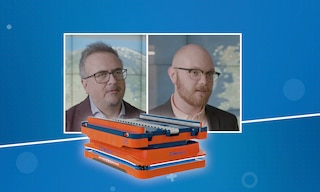
Interview with MIT CTL’s Rodrigo Hermosilla and Willem Guter
“The new generation of AMRs is driving warehouses towards a more proactive model”
About the research project
Autonomous mobile robots (AMRs) are intelligent vehicles that navigate warehouses to automate and streamline internal goods transport. One of the goals of the research collaboration between the Massachusetts Institute of Technology (MIT) and Mecalux is the control and optimisation of AMRs. Rodrigo Hermosilla and Willem Guter, from MIT’s Center for Transportation & Logistics (CTL), are researchers in this initiative led by the Intelligent Logistics Systems Lab. The project seeks to harness collective intelligence to make AMRs even more agile and efficient in warehouses and distribution centres.
Mecalux sits down with Rodrigo Hermosilla and Willem Guter, Researchers at MIT CTL, to learn more about their joint project with Mecalux aiming to make AMRs more agile and efficient.
-
You’re taking part in an innovation project on AMRs. How are you training the robots to work interdependently?
Rodrigo Hermosilla: This research project aims to improve how autonomous mobile robots work within warehouse environments. We’re increasing their efficiency, enabling them to avoid collisions in real time.
Willem Guter: We’re using reinforcement learning to help AMRs understand the warehouse on a very interdependent level. This means that they can see where they need to be at any given time, but also anticipate where future orders will be incoming and where they’ll need to be dropped off. This functionality allows them to further optimise their processes.
We’re using reinforcement learning to help AMRs understand the warehouse on an interdependent level
-
How will this new AMR control algorithm improve performance?
Willem Guter: The performance gains of the novel algorithm are twofold. Firstly, at the warehouse level, it delays the dispatching of tasks to the AMRs, which reduces congestion at pick-up/drop-off points and during travel. Secondly, the algorithm improves positioning performance. It knows or predicts where orders will be coming in and can pre-position AMRs or leave robots already at that location in place.
Rodrigo Hermosilla: We’re developing testbeds in collaboration with Mecalux to ensure they are as realistic as possible — not only regarding layout representation but also in physical behaviours such as acceleration, speed and constraints, among others.
-
How will this AMR model use predictive AI to anticipate requests?
Willem Guter: The model we’re developing will leverage deep learning to predict the origin of orders. This helps with planning on both a near-future and seasonal level. By learning from historical data, it can understand the greater context of where these orders are coming from and going.
-
How are you training AMRs to self-optimise?

We’re training these models so that other AMRs can learn and respond with an optimal solution, not only for one unit but for the whole group Rodrigo Hermosilla: In our research, AMRs are designed as intelligent agents. This means we build a logical representation of each robot, where they can use their own information to make decisions and share certain constraints or events delivered from the environment. Therefore, we need to train these models so that other AMRs can learn and respond with an optimal solution, not only for one unit but for several groups of robots.
-
How will this new generation of AMRs reshape warehouses?
Rodrigo Hermosilla: The most obvious benefit of this kind of technology is the processing time to obtain an optimal solution. Machine learning can infer solutions in real time and is more agile than other algorithms.
Willem Guter: I see the new generation of AMRs and advanced control algorithms shifting warehouses from a reactive model to a more proactive one. This means robots anticipate their positioning, know where orders are coming in and where they’re headed, and optimise workflows accordingly. It can lead to more efficient, greener and less costly warehouses.
